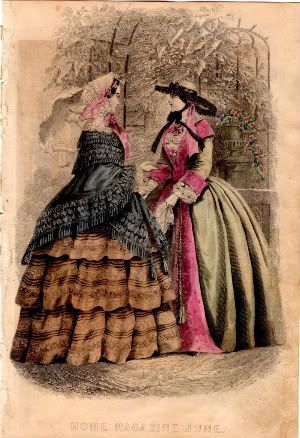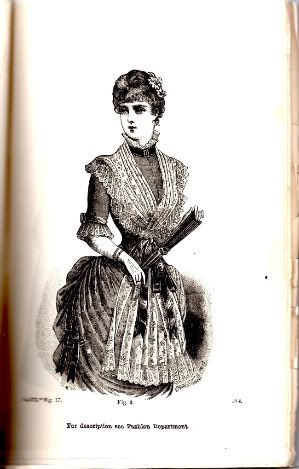I bought this plate for a few reasons. I love the violet and the vivid green, and I absolutely love the detail. I’ll never know just how people manage to draw lace. (Seriously, how does one do that?) But mostly, it amuses me that the woman with the parasol looks like such a bitch. Generally, the figures in fashion plates are all tranquil, dainty femininity, and this one looks like she has places to go and people to kill.
This plate did come with the original fashion description provided by Englishwoman’s Domestic Magazine:
It will be convenient to our subscribers to know that Messrs. Grant and Gask, 58 Oxford-street, London, W., have made arrangements for supplying in material fac-similes of the toilets illustrated in this month’s coloured plate. The prices are given of each garment, so that by this means we are able to conform to the wishes expressed by so many of those who patronize our Magazine. Besides the advantage derived from this information, there will be the saving of a great deal of trouble in much correspondence for our subscribers. We may add that Messrs. Grant and Gask will be happy to supply patterns of the dresses, &c., on application.
TOILETTE HABILLEE. – Bonnet of white crape, trimmed with a plume of white feathers, and a drooping feather at the side. A pointed piece of tulle, edged with a narrow ruche of pleated tulle, covers the Marie Stuart point in front; and the cap is made of the same pleated tulle, narrow at the sides, and very full at the top. Dress of Solferino silk, brocaded in black. The mantle is made of the very fashionable lace called “dentelle de yak,” of which we have already spoken in previous numbers. It is trimmed with white tassels, and rows of white gimp round the neck. The parasol, which is covered with tiny marabout feathers, matches the dress in colour. Price of mantle, 6 guineas; brocaded silk dress, 44 guineas.
AUTUMN WALKING TOILET. – The dress is of green mohair, trimmed with bands of green silk, and tassels. The bodice has two points in front, and a pleated tail behind. The trimming is arranged to imitate a jacket, this trimming being continued behind on the tail. The sleeves are open, but very narrow, and reach nearly to the wrist. A flounce of pleated mohair is put on the bottom of the skirt. The bonnet is of white crape, covered with black tulle, and trimmed with coloured ribbon. A large bunch of straw, crossed in the centre by a coloured knot, forms the bandeau. Price of mohair dress, trimmed, complete, 45 shillings; silk ditto, 5 guineas.
Madame Adolphe Gouband, 248, Strand, London, W.C., supplies paper models of the various articles illustrated in this coloured plate at the following prices: - Mohair dress, complete, 5 s., 6 d.; trimmed gored skirt, 3 s.; bodice and sleeve, 3 s.; sleeve, 1 s. 6 d. A flat pattern is given with each made-up model.I guess gone are the days that “dentelle de yak,” “a flounce of pleated mohair,” a “bunch of straw,” and a “gored skirt” sound at all elegant.
Purchased on ebay as a loose fashion plate in December 2010.








